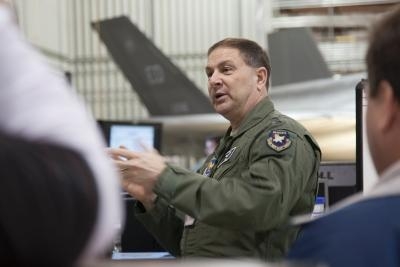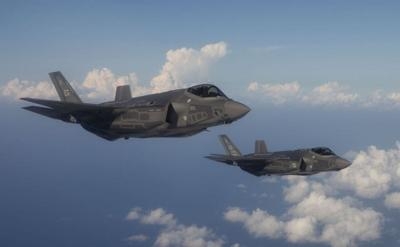Bogdan: Program 'Is Accelerating, Growing, And Changing'
The F-35 Lightning II joint strike fighter program is moving forward while addressing various challenges, according to the program's executive officer.

"In the big picture, I would tell you that the program right now is accelerating, growing and changing," Air Force Lt. Gen. Christopher C. Bogdan (pictured) said at a media roundtable in Arlington, Virginia.
He detailed a number of challenges in the program, including incorporating fixes to address the current flight restrictions on lightweight pilots. "The mark of a good program is you find the problems, you solve the problems and you keep the program moving forward without derailing it," he said.
The development program, he said, is scheduled to be completed in the fall of 2017. "What we're trying to do right now is work toward that very large $50-plus-billion contract and turn that into a modernization program," he said, adding that the program will have to be more efficient than has been the case in the last 15 or more years.
The program currently has 419 deficiencies to be corrected, Bogdan said, explaining that the figure is "not that many." Despite the challenges, he added, the program is advancing. "We are making progress,” the general said. “Sometimes it's not as fast as we want. Sometimes it's messy. Sometimes we have setbacks.”
The problems include issues with software, hardware, and the Autonomic Logistics Information System, or ALIS. He noted that 700 to 800 deficiencies already have been addressed.
Due to a possible risk of neck injury should ejection be necessary, lightweight pilots are restricted from flying the F-35s. For a pilot weighing between 103 and 136 pounds, Bogdan said, the odds of that person having to eject and then being injured in the ejection are one in 50,000. The changes being implemented include a "heavy/light" weight switch, the general said. When in the "light" position, the seat would delay the parachute's extraction by milliseconds if the pilot had to eject, so the shock and stress on the neck would be reduced, he explained. A restraining device also was sewn into the risers behind the parachute so that if a lightweight pilot were to eject at a "weird angle" it would stop the pilot's head from going backward, he added.

The head restraint and the seat switch have been tested, and they work, he said, adding that those fixes are ready to go into the field and in production by the end of the year.
Meanwhile, Bogdan said, the helmet's weight has to be reduced from 5.1 pounds to between 4.6 and 4.8 pounds. That change is lagging behind the other fixes by at least eight or nine months. "I don't like that," he added, noting that all three solutions must be in place before the restriction on lightweight pilots can be lifted.
Bogdan said the Air Force's announcement yesterday that it intends to buy 43, rather than 48, F-35s in fiscal year 2017 is "almost a non-news event." The Air Force is deferring purchases, not cutting airplanes, he explained.
The Navy kept its fiscal 2017 “C” models of the jet at four, and the Marine Corps went from 14 to 16 airplanes for the “B” model, he said, noting that amounts to a net loss of three airplanes for the U.S. services.
The program plans to deliver more than 870 airplanes over the next six years, Bogdan said, adding that one can "barely measure" the reduction from the Air Force in that timeframe, he said.
The general said he is looking at the program "holistically," taking into account international partners as well as possible future customers.
(Source: Air Force Press Service. Image from file)
 ANN's Daily Aero-Term (04.26.24): DETRESFA (Distress Phrase)
ANN's Daily Aero-Term (04.26.24): DETRESFA (Distress Phrase) ANN's Daily Aero-Linx (04.26.24)
ANN's Daily Aero-Linx (04.26.24) Airborne 04.22.24: Rotor X Worsens, Airport Fees 4 FNB?, USMC Drone Pilot
Airborne 04.22.24: Rotor X Worsens, Airport Fees 4 FNB?, USMC Drone Pilot Airborne 04.24.24: INTEGRAL E, Elixir USA, M700 RVSM
Airborne 04.24.24: INTEGRAL E, Elixir USA, M700 RVSM Airborne-NextGen 04.23.24: UAVOS UVH 170, magni650 Engine, World eVTOL Directory
Airborne-NextGen 04.23.24: UAVOS UVH 170, magni650 Engine, World eVTOL Directory




